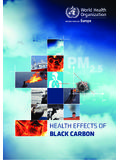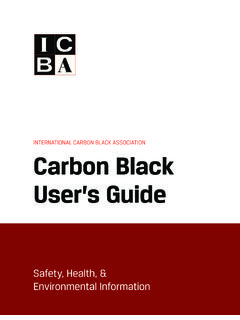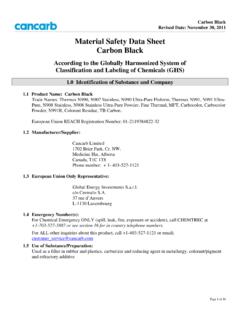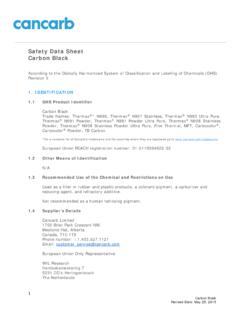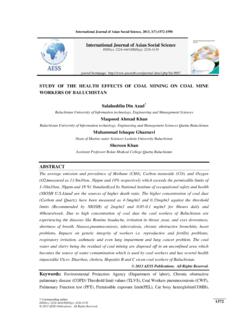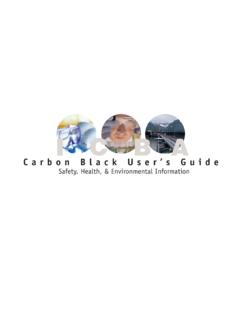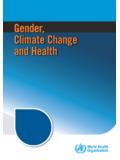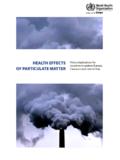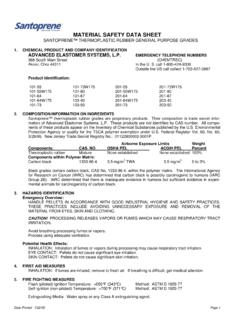Transcription of REINFORCING FILLERS IN THE RUBBER INDUSTRY …
1 ETRMA Aisbl Tel +32 2 218 49 40 2/12 Avenue des Arts Fax +32 2 218 61 62 1210 Brussels Belgium EC Register : ID 60253208 FACT SHEET Updated on January 2012 REINFORCING FILLERS IN THE RUBBER INDUSTRY Assessment as potential nanomaterials with a focus on tyres Table of Contents Executive Summary .. 2 1. INTRODUCTION .. 3 2. TYPES OF REINFORCING FILLERS IN THE TYRE INDUSTRY AND THEIR ROLE IN TYRE PERFORMANCE .. 3 3. PHYSICAL CHARACTERISTICS OF REINFORCING FILLERS USED IN THE RUBBER 5 AMORPHOUS SILICA .. 6 carbon 7 4. TOXICOLOGY OF REINFORCING FILLERS USED IN THE RUBBER INDUSTRY .. 8 AMORPHOUS SILICA .. 8 carbon 9 5. CONCLUSIONS .. 10 6. REFERENCES .. 11 For further information contact the European Tyre and RUBBER Manufacturers Association: Mrs Fazilet Cinaralp, Secretary General, Mr Lorenzo Zullo, Coordinator Chemicals and Environment Legislation, 2 ETRMA Aisbl Tel +32 2 218 49 40 2/12 Avenue des Arts Fax +32 2 218 61 62 1210 Brussels Belgium EC Register : ID 60253208 Executive Summary Amorphous silica and carbon black have been used as REINFORCING FILLERS in the RUBBER INDUSTRY for decades.
2 Their presence in RUBBER is essential to achieve longer wearing products, increased tyre strength and longevity and, especially for silica, decreased greenhouse gas emissions of the vehicles using these tyres. Despite a long history of safe use in the RUBBER and tyre INDUSTRY , these FILLERS are being associated with man made nanomaterials, which are being intensely studied for their potential adverse health effects and are the subject of pending regulatory controls. This paper provides information regarding the INDUSTRY s use of these FILLERS , differentiates the filler materials used by the INDUSTRY according to their particle sizes, and summarizes the state of knowledge with respect to the toxicological properties of amorphous silica and carbon black FILLERS .
3 In RUBBER INDUSTRY applications, amorphous silica and carbon black are used in a form that exceeds all proposed size dimensions for nanomaterials. Although both amorphous silica and carbon black have primary particle sizes in the nanoscale, the particles to which workers may be exposed during raw materials handling are in the micrometer size range as a result of aggregation and agglomeration. Aggregates and agglomerates are difficult or nearly impossible to dissociate under standard handling conditions. Furthermore, both amorphous silica and carbon black are used in the tyre INDUSTRY in forms that are designed to reduce dustiness of the material, including pellets and micropearls.
4 As a result, the exposure of workers to nanoscale particles when handling these materials in the tyre INDUSTRY is expected to be negligible. Work is ongoing in the tyre INDUSTRY to verify this conclusion. In addition to what is known about the physical characteristics of amorphous silica and carbon black as they are used in the tyre INDUSTRY , it is also well established that, from a toxicological perspective, neither are likely to represent a health risk. Although animal studies on some forms of amorphous silica and carbon black , particularly those evaluated for their nanoscale properties, indicate adverse effects may occur with exposure, numerous studies have indicated that there is no evidence of human health risks related to carbon black or amorphous silica as used in the RUBBER INDUSTRY when air concentrations are below the established occupational exposure limits.
5 Based on physical characteristics, exposure to amorphous silica and carbon black used in the RUBBER and tyre INDUSTRY is not likely to result in exposure to nanoscale particles, primarily due to aggregation and agglomeration of the particles. Furthermore, from a toxicological perspective, it appears that existing regulations on amorphous silica and carbon black are sufficiently health protective. Accordingly, additional or different regulation is not necessary to ensure continued safe use of these materials in the RUBBER and tyre INDUSTRY . 3 ETRMA Aisbl Tel +32 2 218 49 40 2/12 Avenue des Arts Fax +32 2 218 61 62 1210 Brussels Belgium EC Register : ID 60253208 1. INTRODUCTION With the rapid emergence of the field of nanotechnology, regulations specific to nanomaterials are under development.
6 One of the key issues hindering regulation is a lack of agreement on the definition of what constitutes a nanomaterial. Currently, the most comprehensive and internationally recognized definition of nanomaterials is presented by the International Standards Organization (ISO). The ISO definition distinguishes between two subgroups, nano objects and nanostructured materials, and defines them as follows: [1] Nano objects are materials that exist in defined singular form that have at least one dimension in the nano scale, < 100 nm. These include nano particles (3 dimensions in nano scale), nanofibres (2 dimensions) and nano plates (one dimension). Nanostructured materials are materials that have structural features on the nano scale but whose particle size is typically greater than 100 nm.
7 Examples of these are materials that primarily exist in aggregated and/or agglomerated forms. A recently published paper by the European Commission Joint Research Centre (JRC) suggests the use of the more specific term particulate nanomaterials to identify materials which are in a particulate form at the nanoscale and are mobile in their immediate environment, and thus might raise health and safety concerns [2]. The JRC acknowledges that composite materials such as the RUBBER compounds used in tyres have been on the market for a long time already, have never been considered as a special technology due to nano ingredients and would not qualify as products of nanotechnology under this definition.
8 Recently, health concerns have been raised with regards to nano objects, because their exceptionally small size may cause them to act and move differently in the human body than the same substances in larger sizes. Therefore, in evaluating whether a substance should be regarded as a nanomaterial requiring special precautions, it is important to consider its properties with respect to aggregation and agglomeration, ultimate particle size, and toxicity. The purpose of this report is to provide information regarding the INDUSTRY s use of amorphous silica and carbon black as REINFORCING FILLERS , clearly establish the physical characteristics of the filler materials, particularly as they relate to particle size during handling in the tyre manufacturing setting, and summarize the state of knowledge with respect to the toxicological properties of the amorphous silica and carbon black FILLERS .
9 2. TYPES OF REINFORCING FILLERS IN THE TYRE INDUSTRY AND THEIR ROLE IN TYRE PERFORMANCE The primary REINFORCING FILLERS used for the production of RUBBER articles are precipitated amorphous silica and carbon black . These materials are delivered in bulk via rail cars, trucks, or large sacks (supersacks). On arrival they are transferred to and stored in silos. These silos feed the internal mixers that are used to manufacture tyre compounds via a system of pipes and weigh scales. The mixer is a large vessel equipped with two rotating paddles (or rotors) connected to a motor of very strong power (more than 1200 KW). The compound production is a batch process where the RUBBER and the REINFORCING filler are introduced into the internal mixer and the rotation of the paddles causes high energy shearing inside the mixer between the RUBBER , filler and other chemicals.
10 This shearing causes an intimate mixing (or dispersion) to occur of the FILLERS and chemicals into the RUBBER matrix. Figure 1 below shows a typical distribution of REINFORCING filler in a RUBBER compound after mixing in the internal mixer (Internal Tyre Company Documents). A discussion of the REINFORCING FILLERS and the characteristics of these materials from their manufacture to use in the tyre INDUSTRY can be found in section 3. 4 ETRMA Aisbl Tel +32 2 218 49 40 2/12 Avenue des Arts Fax +32 2 218 61 62 1210 Brussels Belgium EC Register : ID 60253208 Figure 2. REINFORCING filler in RUBBER after mixing in internal mixer Tyres have a wide range of performance requirements.


